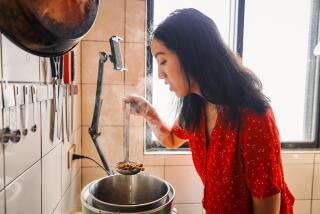Tea on the Rocks
- Share via
After water, tea is the most consumed beverage in the world. Yet it is only in America that tea is served over ice.
The hot climate of the South--where the vast majority of the country’s tea is consumed--may partially explain our preference for iced tea, but consider that the world’s greatest tea drinkers, the British, never stopped drinking their tea hot, even when they presided over their exceedingly tropical colony, India.
Many an American’s quest for a quick cold tea has ended in opening a can or a bottle. Shameful, really, because making your own vastly superior iced tea requires only two ingredients, one of which is water.
Once you’ve made the decision to make your own iced tea, two burning questions present themselves: Should you use the same tea to make iced tea as hot? And is there a quicker way to make iced tea than cooling down an equivalent amount of hot tea?
First, the question of the tea. Though many iced-tea drinkers will happily quaff any decent quality tea cold, connoisseurs maintain that only certain teas are appropriate over ice.
“The teas that make the best hot teas don’t make the best iced teas,” says John Martinson, co-founder and president of China Mist Tea Co., a supplier of iced-tea ingredients and equipment for restaurants and hotels.
The difference between a good hot tea and a good iced tea, says Martinson, is in the amount of tannin in the leaves. (Tannin, wine drinkers know, is the bitter substance also found in grape skins that gives red wine its characteristic bite.)
“When you brew a high-tannin tea,” says Martinson, “it tastes great hot. But ice makes it taste bitter and dry, and it will cloud up like chocolate milk. For iced tea, you want teas that are low in tannins.” Lemon, despite its acidic kick, does tend to smooth out the flavor of slightly tannic tea, he says.
Harney & Sons, a mail order purveyor of fine teas that sells a number of special iced-tea blends, has gone to great lengths to find a tea that works well over ice. Mike Harney, who runs the company with his father and brother, says the search ended with “a specific tea from northern China that handles the ice and the dilution without growing cloudy.”
Lipton, the country’s leading tea producer, also sells a line of products designed especially for the iced-tea drinker. For years, the company has sold an “Iced Tea Brew,” a blend of black teas particularly suited to being served over ice. The tea is sold, in individual serving- and pitcher-sized bags, throughout the South and more spottily in other parts of the country.
This year, Lipton introduced its “Cold Brew Blend,” tea bags that infuse in cold tap water in five minutes. “It’s a great convenience for people who have never before brewed their own iced tea,” says John Caron, Lipton’s vice president of beverages.
Getting iced tea right is not a sideline for Lipton. According to Caron, roughly 80% of the tea drunk in the United States is drunk over ice.
One way to ensure that your tea will taste good iced is to purchase a tea that is so labeled, such as Harney’s Black Currant Iced Tea Blend, ($12 for 30 quart-sized bags) or Lipton’s Cold Brew Blend ($2.79 for 24 quart-sized bags).
When asked which specific teas fit the iced-tea bill, Lipton’s Caron and China Mist’s Martinson refuse to divulge the sources of their teas. Mike Harney is slightly more forthcoming, citing Darjeeling and Assam as two teas that are not ideal for icing and adding, “Ceylon does a pretty nice job.”
Harney also explains a quick method for brewing iced tea. “If you want to do a quart,” he says, “take a quarter ounce of tea and a cup of boiling water and brew for 15 minutes. That will take it down to room temperature. Then add three cups of cold tap water to the concentrate and you’ll have one quart of iced.” Harney cautions against putting the hot concentrate in the refrigerator, because “cooling down too quickly causes cloudiness.”
This basic concentrate method can be speeded up if more tea is used. Thus Lipton’s Caron, whose tea is markedly less expensive than Harney’s, advises: “Boil a little water, put a lot of tea bags into it, and sugar if you want it. Let it steep for three to five minutes, then dilute with cold water. It beats anything out of a can.”
To sweeten or not to sweeten: Among the tea cognoscenti, unsweetened tea is always preferred, as sugar tends to mask the character. But many folks believe there are times when nothing but sweetened iced tea will do.
If you’ve tried to stir granulated sugar into ice-cold tea, you know it’s a toss-up as to whether this method is more frustrating or time-consuming.
Better to add sugar when the tea is still hot or to use superfine sugar when it’s cold. Real tea nuts may want to cook up a batch of simple syrup (equal parts sugar and water cooked until the sugar has dissolved and the mixture is clear) and serve it alongside the tea in a small pitcher.
Finally, a word about the dreaded cloudiness. John Harney counsels, “If your iced tea does get cloudy, add a little shot of hot water to it and it should clear up.”
More to Read
Eat your way across L.A.
Get our weekly Tasting Notes newsletter for reviews, news and more.
You may occasionally receive promotional content from the Los Angeles Times.






